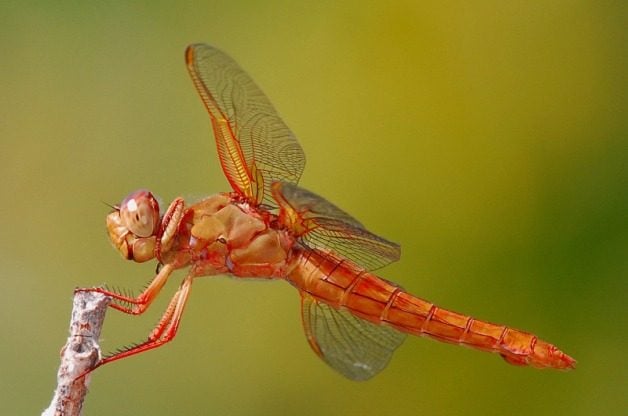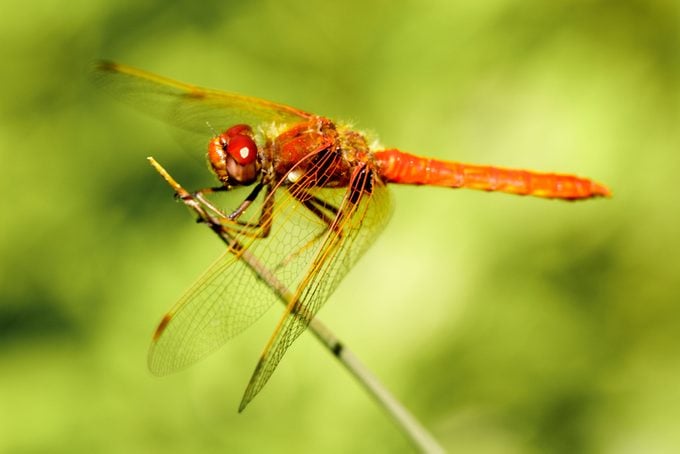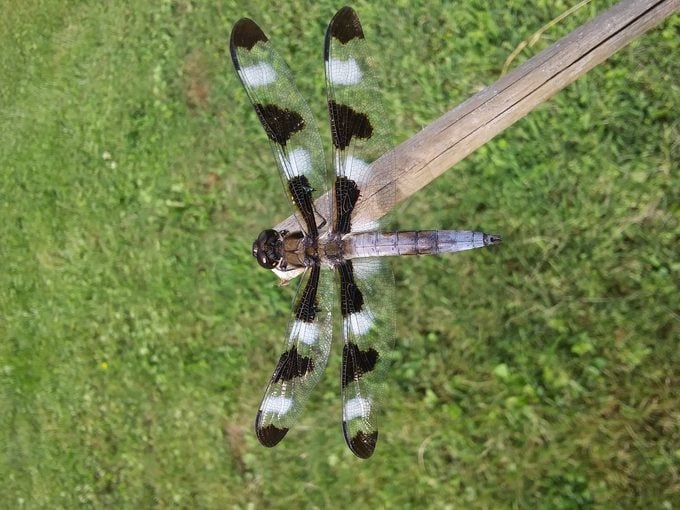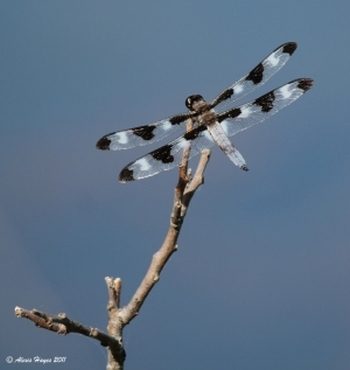Meet the Skimmers: Colorful Dragonflies
Updated: Nov. 03, 2022
The skimmer dragonfly eats pest insects, making it a very good bug for your garden. Here's how to identify and attract them.
Are Skimmers Dragonflies?

My fascination with skimmers (a flashy family of dragonflies) began many years ago. I was picking a few sprigs of fresh rosemary from my garden when I caught a glimpse of a dragonfly out of the corner of my eye. As I carefully inched closer, I noticed its distinctive dark chocolate-and-gray boldly patterned wings and yellow dorsal stripe—a telltale sign of a female widow skimmer. A few days later, I spotted a flame skimmer poised on a metal dragonfly perch in bright sunlight, showing off its brilliant coloration of orange red, much like the hue of a flaming coastal sunset. I was captivated by these beneficial garden insects.
Marvel at the beauty of dragonflies with these 12 dazzling dragonfly photos.
What Do Skimmers Look Like?

Skimmers are unique among dragonflies for their diversity of colors, wing patterns and habits. They arguably are the most easily identifiable group due to their beautiful coloration and uniquely patterned wings, which can be quite showy. They’re also easy to observe because of their tendency to remain still and return to the same spot between flights.
These day-flying creatures take center stage during the warm, sunny days of summer when birding activity is dwindling. But you can see skimmers on the wing anytime from spring to fall, depending on the species and region.
With bodies up to 2-1/2 inches long, these garden bugs aren’t quite as large as darners. But what they lack in size, they make up for with their colorful and assertive nature. In fact, their behavior can be as showy as their appearance.
Males typically are very territorial at breeding sites, displaying aggression by chasing competing males in what can be likened to an aviation performance of vertical loops and side-by-side flight displays. And they glide with amazing speed while chasing insects like mosquitoes. (Natural pest control is another reason they’re very good bugs for your garden.)
These pictures will change how you see bugs.
How to Attract a Skimmer Dragonfly
While common around water, they also frequent backyard gardens—even ones like mine that lack a pond. They’ll perch on garden plants to scout potential insect prey or soak up warmth from a sun-drenched stone.
To make your garden more attractive to skimmers, give them three things: food, water and places to perch. Keep your garden chemical-free and grow flowers rich in nectar to help create a continual bug buffet. Even something as small as a bird bath can provide the water. Perching spots usually aren’t a problem since by its very nature, a garden already has plenty such places. And don’t forget a cozy bench or chair parked near a flower bed. After all, you’ll want a front row seat to enjoy the skimmer show!
Psst—we found 8 bugs you should never kill in your garden.
6 Plants to Grow for Skimmers

- Aster (Aster spp)—Perennial with a profusion of daisylike flowers from late summer through fall. Grows in full sun from 6-inch compact mounds to spreading plants up to 6 feet in height. Zones 3 to 8.
- Cleome (Cleome hasslerana)—Marginally frost-hardy annual bearing clusters of spiderlike summer flowers. Flowers may self seed and stems are often spiny. Grows from 4 to 6 feet tall in full sun.
- Coneflower (Echinacea spp)—Long-blooming perennial with daisy-like flowers summer through fall. A drought-tolerant and heat-resistant choice, it grows from 1 to 5 feet tall in full sun to light shade. Zones 3 to 9.
- Coreopsis (Coreopsis spp)—Easy-to-grow perennials and annuals that bloom profusely from summer through fall. Compact plants with self-sowing tendencies grow from 1 to 4 feet tall in full sun. Zones 3 to 11.
- Rudbeckia (Rudbeckia spp)—Also known as coneflower, gloriosa daisy or black-eyed Susan, these showy annuals and perennials produce daisylike flowers from summer to fall. The plants grow in full sun to 6 feet tall, with dwarf strains 1 to 2 feet tall. Zones 3 to 9.
- Zinnia (Zinnia spp)—Hot weather annuals flower in full sun from summer until frost. Zinnias grow in a diversity of shapes, sizes and colors, from 12 inches to 4 feet tall.
Skimmer Dragonflies to Look for in Your Yard

Twelve-Spotted Skimmer (Libellula pulchella, wingspan 3 inches) You’ll notice these dragonflies throughout the summer, flying over gardens looking for food. Because they have multifaceted eyes, they are great hunters that eat all sorts of insects, especially mosquitoes.
Widow Skimmer Dragonfly (Libellula luctuosa, wingspan 3 inches) You can often spot this common dragonfly perched upon the tip of a stick or branch, staking out a territory for hunting. They will chase off other dragonflies. They eat mosquitoes and many other insects. White patches on the wings and the pale blue abdomen identify the males. The female has no white on her wings, and her abdomen is brown with orange stripes on the sides.
Flame Skimmer (Libellula saturata) This red colored dragonfly is common in some parts of the West.
